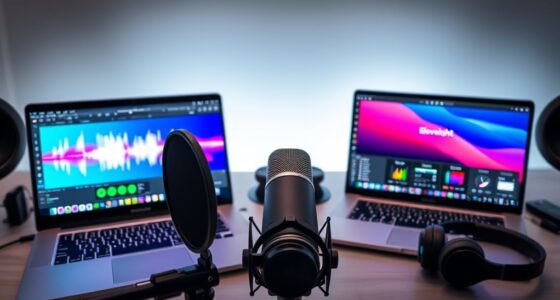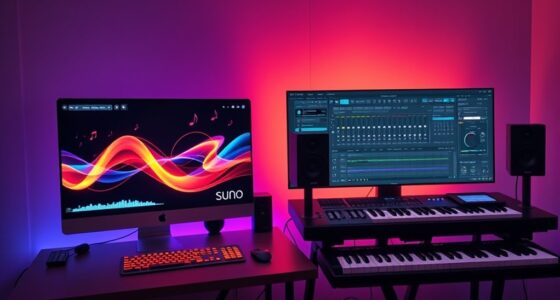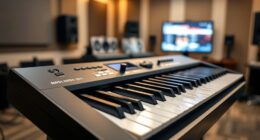If you’re choosing between Otter.ai and Notion AI for note-taking and transcription, consider Otter’s strong real-time transcription accuracy, speaker recognition, and seamless integration with Zoom, ideal for meetings and collaborative projects. Notion AI offers flexible organization, deep customization, and project management features suited for extensive note organization and workflow integration. Both tools have different strengths, so exploring their features further will help you decide which fits your workflow best.
Key Takeaways
- Otter.ai excels in real-time transcription, speaker identification, and seamless integration with Zoom and Slack.
- Notion AI combines transcription with extensive note organization, project management, and cross-platform search capabilities.
- Otter.ai offers specialized, high-accuracy speech recognition for meetings and lectures, with collaborative editing features.
- Notion AI provides customizable workspace features, supporting multimedia embedding and detailed content structuring.
- Pricing and user interface vary: Otter.ai emphasizes simplicity and affordability, while Notion AI offers deep customization within a multifunctional platform.
Transcription Accuracy and Clarity
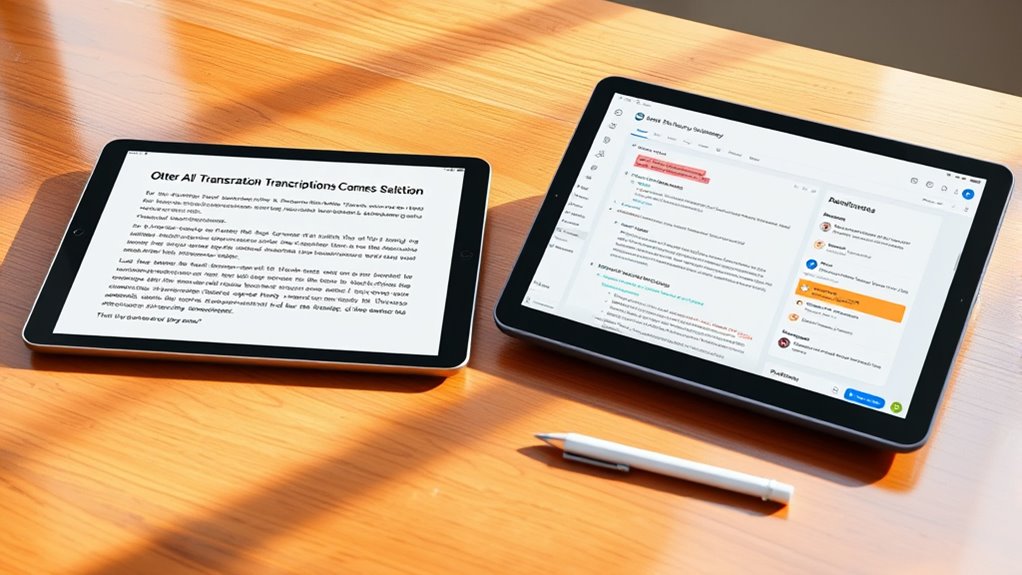
Transcription accuracy and clarity are crucial when choosing an AI-powered note taker. Otter.ai offers automated transcriptions with accuracy rates between 85-90%, but it requires proofreading for perfect results, especially with strong accents or noisy backgrounds. Rev’s automated service matches Otter.ai at around 90%, while human transcription can reach nearly 99%, though at a higher cost. Notion AI’s accuracy isn’t explicitly published but is generally less precise, focusing more on integration within the workspace. Otter.ai’s transcripts are interactive, allowing edits, speaker differentiation, and highlighting, which improves clarity. Its real-time transcription works well during meetings, especially with platform integrations. However, accuracy can suffer with overlapping speakers or background noise, impacting overall transcript clarity. Additionally, noise reduction features in some tools help enhance transcription quality in challenging audio environments. Furthermore, transcription accuracy can be affected by audio quality and the complexity of speech, emphasizing the importance of choosing the right tool for specific needs. Given the increasing reliance on AI security measures, ensuring the confidentiality and integrity of transcribed data is also an essential consideration when selecting a transcription tool. As automation advances, the integration of robust data privacy protections becomes increasingly vital to maintain user trust.
Key Features and Functional Capabilities
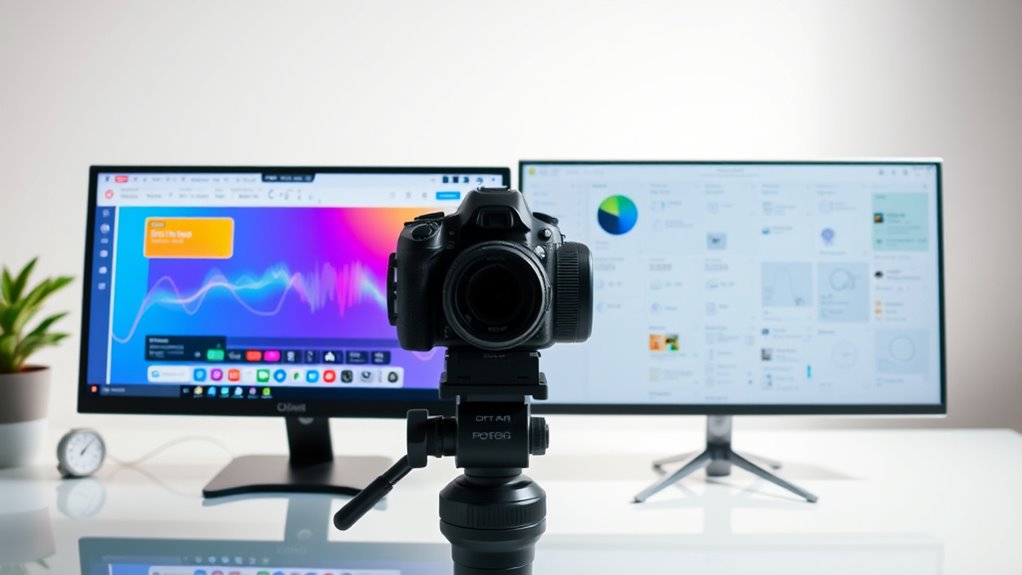
AI-powered note takers like Otter.ai and Notion AI offer a range of features that enhance how you capture, organize, and utilize meeting content. Otter.ai specializes in real-time transcription in English, Spanish, and French, and allows you to comment, edit transcripts, and share folders for collaboration. It can generate summaries, outlines, and follow-up emails automatically. Notion AI integrates transcription within its note system, enabling you to start AI Meeting Notes via the calendar or commands, with transcripts that are searchable across connected apps like Slack and Google Workspace. It excels at project management, turning transcripts into actionable tasks and generating reports. Both tools leverage AI to transform raw transcripts into useful summaries, but Otter AI focuses on transcription and collaboration, while Notion AI emphasizes organization and project integration. Additionally, the accuracy of the transcriptions can be influenced by the audio quality of the recordings, which is a crucial factor in achieving reliable results.
Ecosystem Integration and Compatibility
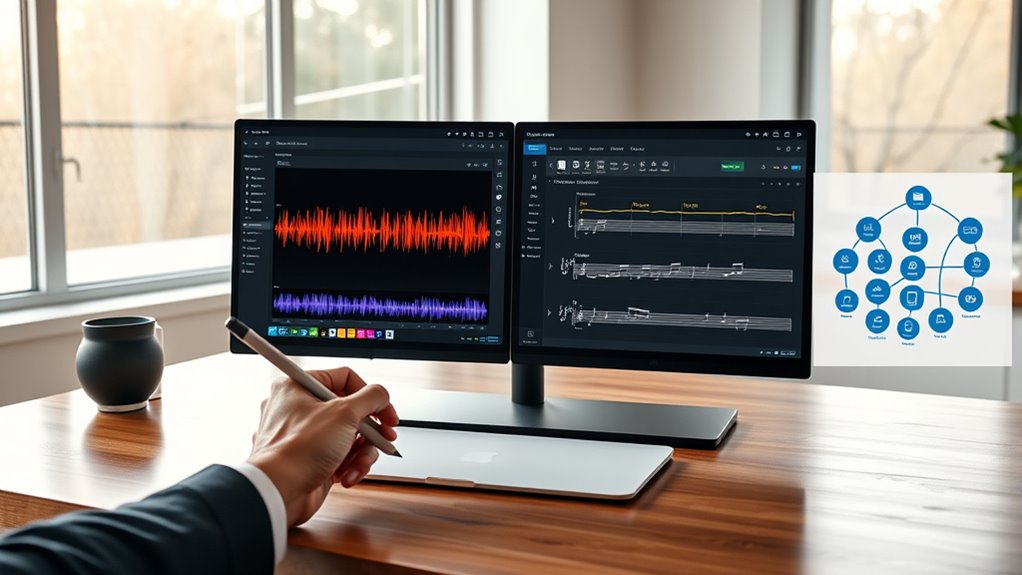
Your choice of note taker depends heavily on how well it connects with your existing tools and workflows. Platforms like Otter.ai offer seamless integrations with Zoom, Google Calendar, and Slack, making automation straightforward, while Notion AI focuses on syncing within its own workspace and related apps. Understanding their cross-device capabilities and automation features helps you pick the solution that best fits your daily routines. Additionally, considering privacy and consent is crucial when selecting a platform to ensure your data is handled responsibly. When evaluating these tools, it’s also important to consider how they handle data security and compliance with relevant regulations. Incorporating space and organization features can further enhance productivity by keeping your notes tidy and accessible.
Platform Connectivity Options
Platform connectivity options are essential for maximizing the efficiency of note-taking tools, as they determine how seamlessly these applications integrate into your existing workflow. Notion AI offers deep integration with Slack, Google Workspace, and Github, allowing you to search and pull information across platforms without leaving your workspace. It supports multiple devices and platforms through the Notion app, ensuring ecosystem consistency. You can trigger AI meeting notes via calendar notifications or slash commands, making workflow smooth. Notion AI also connects directly to communication tools like Slack, enabling natural language queries and linking conversations to projects. Otter AI, on the other hand, mainly focuses on transcription, supporting Zoom and multilingual transcription. Its integrations are more limited, lacking the extensive ecosystem connections that Notion AI provides, which can restrict seamless cross-platform collaboration. Additionally, ecosystem integration plays a crucial role in enhancing productivity by allowing efficient data sharing across various applications and devices. Incorporating platform connectivity options enhances the overall user experience by supporting versatile workflows and device synchronization. Moreover, seamless integration with natural language processing features helps streamline note management and retrieval, further improving efficiency.
Workflow Automation Capabilities
Workflow automation capabilities in note-taking tools considerably enhance productivity by seamlessly integrating meeting content into your existing workflows. Otter.ai excels at real-time action item extraction and can automatically create tasks in platforms like Asana, streamlining follow-ups. Notion Meeting Recorder generates summaries and links directly to project databases, tightly coupling notes with workflows. Otter.ai offers broader external integrations, while Notion focuses on ecosystem-centric automation within its workspace. Both platforms automate but differ in depth: Otter.ai emphasizes immediate task assignment, and Notion integrates notes into structured project management. Additionally, the sustainability of integrations ensures long-term compatibility and reduces maintenance efforts. Ensuring that integrations remain compatible over time is crucial for maintaining a robust workflow automation system. The long-term viability of these integrations plays a vital role in sustaining seamless automation, especially considering the evolving ecosystem compatibility of software platforms.
Cross-Device Synchronization
Cross-device synchronization guarantees that notes and AI features stay current across all your devices, enabling seamless access and editing wherever you are. Otter.ai supports real-time sync on iOS, Android, and web, with offline access but limited functionality without internet. Notion AI offers a broader ecosystem, working on iOS, Android, Web, Windows, and macOS, with instant sync across devices. Both use cloud-based systems, ensuring updates are reflected immediately. Otter.ai integrates natively with platforms like Zoom, Slack, and Microsoft Teams, and connects with over 7,000 apps via Zapier. Notion AI is deeply embedded within the Notion workspace, linking notes, tasks, and databases. While Otter emphasizes meeting transcription, Notion focuses on workspace cohesion and project management.
Pricing Structures and Subscription Options
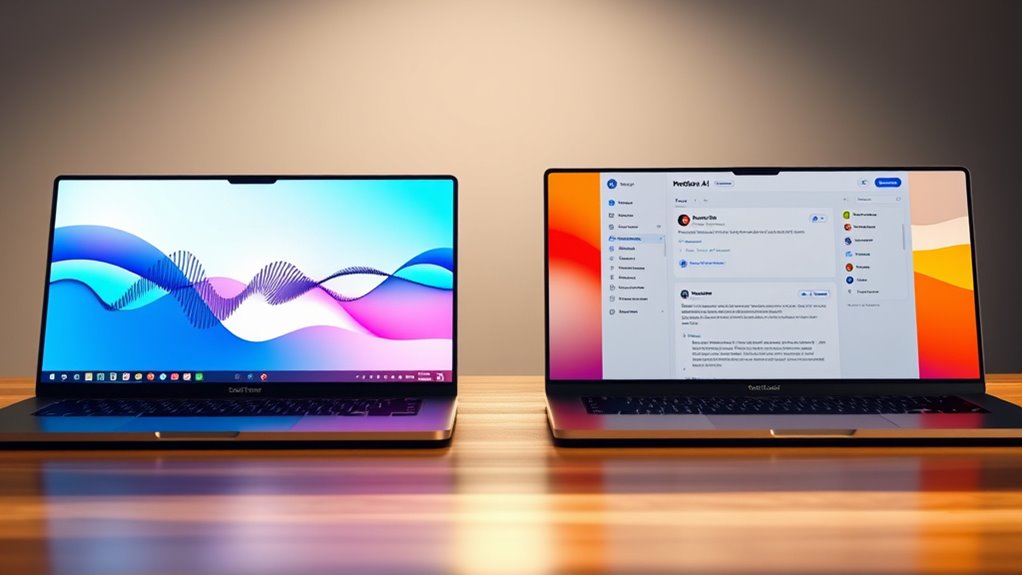
Ai-powered note-taking tools like Otter AI and Notion AI offer a variety of subscription options designed to meet different user needs and budgets. Otter AI’s plans include a free Basic tier with limited features and transcription minutes, perfect for casual users. Its Pro plan costs $8.33/month (annual billing) or $16.99/month (monthly), offering more transcription time and advanced features. Business plans are $20/user/month (annual) or $30/month, adding admin controls and analytics. Enterprise plans are custom-priced for organizations needing security and deployment options. Notion AI’s pricing is integrated into its existing plans, starting at $8/month for the Personal Pro plan with AI credits. Higher tiers for teams and enterprises include more AI capacity, with costs rising accordingly. Understanding the importance of emotional support is crucial for users managing stress or changes related to note-taking or productivity workflows. Additionally, subscription flexibility allows users to upgrade or downgrade plans as their needs evolve, ensuring cost-effective access to features.
User Experience and Interface Design

You’ll find that Otter.ai offers a simple, clean interface focused on transcription clarity, making it easy to navigate during meetings. Notion AI’s interface, however, is more complex due to its multi-functional workspace, which can feel overwhelming at first. When it comes to customization options, Otter’s layout is straightforward, while Notion allows deeper personalization but requires more familiarity to optimize. Additionally, understanding how to manage cookie preferences can enhance user experience and privacy control. For example, optimizing user interface design can significantly improve user engagement and ease of use across different platforms. Moreover, considering essential oil applications and related features can offer insights into integrating advanced technology into user-friendly interfaces.
Interface Customization Options
When it comes to interface customization options, note-taking apps vary considerably in how much you can tailor the user experience to your needs. Otter AI offers a simple, clean interface focused on real-time transcription, with limited options for layout changes or note presentation. In contrast, Notion AI provides a highly adaptable workspace where you can design pages, embed multimedia, and organize content with drag-and-drop ease. Notion supports different view modes like lists, boards, and calendars, enhancing visual flexibility. You can also create and modify templates for various projects, linking notes and building structured databases. While Otter AI emphasizes transcription clarity, Notion prioritizes extensive customization and integration. Additionally, Notion allows for workspace organization that can be tailored to any workflow or project type. Its content management features enable users to develop complex structures suited for diverse needs, making it a versatile tool for both individual and team use. The ability to integrate various tools further expands its customization potential, accommodating different user preferences and requirements. Moreover, the integration of user interface options with accessibility features can enhance usability for diverse users and streamline workflows by reducing energy consumption and optimizing device performance.
Ease of Navigation
Mastering note-taking apps effectively depends on how intuitive their interface design is and how seamlessly they integrate workflows. Otter.ai offers a simple, linear navigation focused on transcription, making it easy to record, review, and export notes quickly. Its minimalist interface emphasizes quick access to recording controls and easy toggling during live sessions. In contrast, Notion AI provides a more complex, modular workspace that combines note-taking with project management tools like databases and calendars. While this offers powerful organization, it can be overwhelming initially. Notion’s hierarchical structure allows detailed navigation through nested pages and content. Both apps support mobile and desktop use, but Otter’s streamlined design favors quick, straightforward interactions, whereas Notion’s flexibility supports more in-depth content management, requiring a learning curve.
Ideal Use Cases and Market Positioning

Ideal use cases and market positioning for AI-powered note takers hinge on their specific strengths and target audiences. Otter AI excels in real-time transcription, especially in professional settings like meetings, lectures, and medical transcription, where speaker identification and accuracy matter. It’s ideal for teams needing detailed analytics and seamless integrations with platforms like Slack and Zoom. Additionally, Otter AI’s ability to support remote collaboration makes it a valuable tool for distributed teams. Furthermore, Otter AI’s capacity to accurately transcribe dialogue with multiple speakers enhances its usefulness in complex conversational environments. Its advanced speech recognition capabilities enable it to handle varied accents and speech patterns effectively, increasing its utility across diverse user groups. Conversely, Notion AI combines note-taking with project management, making it perfect for users who want to synthesize information, create reports, and manage knowledge within one workspace. It’s suited for startups and enterprises seeking an all-in-one productivity tool. Additionally, understanding the content accuracy of these tools is crucial for selecting the right solution for specific needs.
Frequently Asked Questions
Can Otter.Ai Transcribe Multiple Languages Simultaneously?
You’re wondering if Otter.ai can transcribe multiple languages at once. Currently, it cannot. Otter.ai requires you to select a single language for each recording, and it won’t automatically switch or transcribe multiple languages simultaneously. If your meetings involve different languages, you’ll need to create separate recordings or switch the language setting manually. For real-time multi-language transcription, you’d need a platform like Notta AI that supports multiple languages at once.
How Secure Is Data Stored Within Notion AI?
You’re asking how secure your data stored within Notion AI is, and the answer is pretty solid. Notion uses AES-256 encryption for data at rest and TLS protocols for data in transit, so your info is well-guarded. They also implement multi-factor authentication, regular monitoring, and strict access controls. While no system is foolproof, their compliance with SOC 2 and constant security updates keep your data safer than you might think.
Does Otter.Ai Support Offline Transcription Capabilities?
You ask if Otter.ai supports offline transcription, and the answer is no. Otter.ai relies on cloud processing for its real-time transcription features, meaning you need an internet connection for most functions. You can upload pre-recorded files, but processing still happens online. Without internet access, you can’t transcribe or use its AI features, which makes it less suitable for remote or offline scenarios.
Can Notion AI Automate Repetitive Note-Taking Tasks?
Ever imagined having your notes auto-organized after a meeting? You can with Notion AI. It automates repetitive tasks like tagging, categorizing, and linking notes without manual effort. It also generates summaries and action items, streamlining your workflow. While it requires active consent and works only during live sessions, it substantially reduces manual follow-up, helping you focus on what truly matters. Isn’t it time you let AI handle the routine?
How Do Updates and New Features Get Rolled Out for Both Platforms?
You’ll notice that both Otter AI and Notion AI roll out updates differently. Otter AI tends to release major updates quarterly or biannually, with smaller fixes in between, and communicates through a status page, emails, and press releases. Notion AI follows a more continuous, iterative process, adding features regularly through release notes and forums. Both prioritize stability and user feedback, ensuring updates enhance functionality while minimizing disruptions.
Conclusion
As you explore Otter AI and Notion AI, you realize each offers unique strengths—like two roads diverging in a digital forest. Otter’s crisp transcriptions and focus on meetings complement Notion’s versatile workspace, blending productivity with creativity. By choosing the tool that fits your workflow, you might find yourself walking a path where ideas flow effortlessly, and clarity becomes second nature. Sometimes, the right AI companion appears just when you’re ready to turn a new page.




